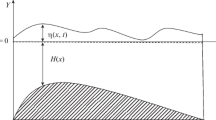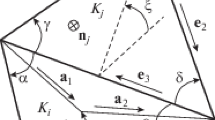Abstract
For the numerical solution of flow problems past a solid body it is worth to consider boundary integral techniques for their inherent capability to manage efficiently the far-field boundary conditions as well as the approximation of the solid body contour. However, for the analysis of large Reynolds number flows, of major interest in the applications, several computational difficulties appear when using the integral representation for the velocity or for the vorticity field in its classical form with interpolating functions (BEM). In particular, the evaluation of the volume integrals is a serious drawback while the steepness of their kernel introduces artificial diffusion in the calculation. To satisfy the opposite requirements of the advective and of the diffusive part of the Navier-Stokes equations, we adopt an operator splitting scheme according to the Chorin-Marsden product formula (Chorin et al. 1978), together with a proper vorticity generation scheme at the solid boundary. A solution procedure based on the approximation of the vorticity field by a finite number of point vortices (PVM) follows as a natural evolution of the boundary integral formulation.
The numerical results given by the two methods for the merging of two like-signed vortices in free space reveal the excessive numerical diffusion of BEM. The better accuracy of PVM is also established through the evaluation of some first integrals of motion. Several results are also reported for flows in presence of solid boundaries where the vorticity generation is crucial. In this case accurate solutions are only obtained with PVM, while BEM is even less satisfactory than in free space. Finally, the proposed vortex-like method (PVM) is tested on the classical problem of the wake behind a cylinder, in comparison with other well established techniques.
Similar content being viewed by others
References
Anderson, C. R. 1989: Vorticity boundary conditions and boundary vorticity generation for two-dimensional viscous incompressible flows. J. Comput. Phys. 80: 72–97
Anderson, C. R. 1989: Observations on vorticity creation boundary conditions. In: Caflish R. E. (ed.): Mathematical Aspects of Vortex Dynamics, pp. 144–159, SIAM
Anderson, C. R.; Reider, M. B. 1993: A high order explicit method for the computation of flow about a circular cylinder, preprint
Beale, J. T.; Greengard, C.; Thomann, E. 1993: Operator splitting for Navier-Stokes and Chorin-Marsden product formula. In: Beale, J. T.; Cottet, G. H.; Hubertson, S. (Eds): Vortex Flows and Related Numerical Methods, pp. 27–38, Kluwer Acad. Publ.
Beale, J. T.; Majda, A. 1985: High order accurate vortex methods with explicit velocity kernels. J. Comput. Phys. 58: 188–208
Buntine, J. D.; Pullin, D. I. 1989: Merger and cancellation of strained vortices J. Fluid Mech., 205: 263–295
Chorin, A. J. 1973: Numerical study of slightly viscous flow. J. Fluid Mech. 57: 785–796
Chorin, A. J. 1978: Vortex sheet approximation of boundary layers. J. Comput. Phys. 27: 428–442
Chorin, A. J.; Hughes, T. J. R.; McCracken, M. F.; Marsden, J. E. 1978: Product formulas and numerical algorithms. Comm. Pure Appl. Math. 31: 205–256
Graziani, G.; Ranucci, M.: A fast vortex method for viscous flows past bodies, to be published.
Graziani, G.; Ranucci, M.; Riccardi, G.; Piva, R. 1994: Viscous vs. inviscid interaction of a vorticity structure with a circular cylinder. Meccanica 29, 4: 465–478
Hou, T. Y.; Wetton, B. T. R. 1992: Convergence of a finite difference scheme for the Navier-Stokes equations using vorticity boundary conditions. SIAM J. Numer. Anal. 29(3): 615–639
Hung, S. C.; Kinney, R. B. 1988: Unsteady viscous flow over a groved wall: a comparison of two numerical methods. Int. J. Numer. Meth. Fluids 8: 1403–1437
Lamb, H. 1932: Hydrodynamics, art. 165, 6th ed., Cambridge: Cambridge Univ. Press
Lighthill, M. J. 1963: Introduction. Boundary layer theory. In: Rosenhead L. (ed.): Laminar Boundary Layers, London: Oxford Univ. Press
Orlandi, P. 1990: Vortex dipole rebound from a wall. Phys. Fluids A 2: 1429–1436
Piva, R.; Graziani, G.; Morino, L. 1987: Boundary Integral equation method for unsteady viscous and inviscid flows. In: Cruse T. A. (ed.): Advances Boundary Element Method, pp. 297–304, New York: Springer Verlag
Piva, R.; Morino, L. 1987: Vector Green's function method for unsteady Navier-Stokes equations. Meccanica 22: 76–85
Quartapelle, L. 1981: Vorticity conditioning in the calculation of two-dimensional viscous flows. J. Comput. Phys. 40: 453–477
Riccardi, G.; Piva, R. 1993: A slightly diffusive contour dynamics. In: Beale, J. T.; Cottet, G. H.; Hubertson, S. (Eds.): Vortex Flows and Related Numerical Methods, pp. 223–239, Kluwer Acad. Publ
Riccardi, G.; Ranucci, M.; Graziani, G.; Piva, R.: Global evolution equations for the dynamics of vorticity structures interacting with a solid body. In preparation
Saffman, P.; Saffman, G. 1979: The approach of a vortex pair to a plane surface in inviscid fluid. J. Fluid Mech. 92: 497–503
Author information
Authors and Affiliations
Additional information
Communicated by H. Antes and T. A. Cruse, 2 August 1994
This work was partly supported by the Italian Ministry for Scientific Research through a MURST grant and by C.N.R. through Progetto Finalizzato “Trasporti II”.
Rights and permissions
About this article
Cite this article
Graziani, G., Ranucci, M. & Piva, R. From a boundary integral formulation to a vortex method for viscous flows. Computational Mechanics 15, 301–314 (1995). https://doi.org/10.1007/BF00372269
Issue Date:
DOI: https://doi.org/10.1007/BF00372269




